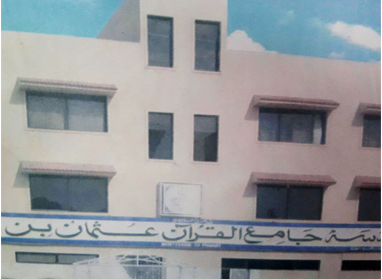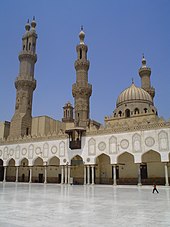Usman Bin Affan School

Usman Bin Affan School
Pre-Nursery to Class 5
Education has played a central role in Islam since Ancient times, owing in part to the centrality of scripture and its study in the Islamic tradition. Before the modern era, education would begin at a young age with study of Arabic and the Quran. Some students would then proceed to training in tafsir (Quranic exegesis) and fiqh (Islamic jurisprudence), which was seen as particularly important. For the first few centuries of Islam, educational settings were entirely informal, but beginning in the 11th and 12th centuries, the ruling elites began to establish institutions of higher religious learning known as madrasas in an effort to secure support and cooperation of the ulema (religious scholars). Madrasas soon multiplied throughout the Islamic world, which helped to spread Islamic learning beyond urban centers and to unite diverse Islamic communities in a shared cultural project.[1] Madrasas were devoted principally to study of Islamic law, but they also offered other subjects such as theology, medicine, and mathematics.[2] Muslims historically distinguished disciplines inherited from pre-Islamic civilizations, such as philosophy and medicine, which they called “sciences of the ancients” or “rational sciences”, from Islamic religious sciences. Sciences of the former type flourished for several centuries, and their transmission formed part of the educational framework in classical and medieval Islam. In some cases, they were supported by institutions such as the House of Wisdom in Baghdad, but more often they were transmitted informally from teacher to student.[1] While formal studies in madrasas were open only to men, women of prominent urban families were commonly educated in private settings and many of them received and later issued ijazas (diplomas) in hadith studies, calligraphy and poetry recitation. Working women learned religious texts and practical skills primarily from each other, though they also received some instruction together with men in mosques and private homes
Education in pre-modern Islam
The centrality of scripture and its study in the Islamic tradition helped to make education a central pillar of the religion in virtually all times and places in the history of Islam.[1] The importance of learning in the Islamic tradition is reflected in a number of hadiths attributed to Muhammad, including one that instructs the faithful to “seek knowledge, even in China”.[1] This injunction was seen to apply particularly to scholars, but also to some extent to the wider Muslim public, as exemplified by the dictum of Al-Zarnuji, “learning is prescribed for us all”.[1] While it is impossible to calculate literacy rates in pre-modern Islamic societies, it is almost certain that they were relatively high, at least in comparison to their European counterparts.[1]
Organized instruction in the Cairo Al-Azhar Mosque began in 978
Education would begin at a young age with study of Arabic and the Quran, either at home or in a primary school, which was often attached to a mosque.[1] Some students would then proceed to training in tafsir (Quranic exegesis) and fiqh (Islamic jurisprudence), which was seen as particularly important.[1] Education focused on memorization, but also trained the more advanced students to participate as readers and writers in the tradition of commentary on the studied texts.[1] It also involved a process of socialization of aspiring scholars, who came from virtually all social backgrounds, into the ranks of the ulema.[1]
For the first few centuries of Islam, educational settings were entirely informal, but beginning in the 11th and 12th centuries, the ruling elites began to establish institutions of higher religious learning known as madrasas in an effort to secure support and cooperation of the ulema.[1] Madrasas soon multiplied throughout the Islamic world, which helped to spread Islamic learning beyond urban centers and to unite diverse Islamic communities in a shared cultural project.[1] Nevertheless, instruction remained focused on individual relationships between students and their teacher.[1] The formal attestation of educational attainment, ijaza, was granted by a particular scholar rather than the institution, and it placed its holder within a genealogy of scholars, which was the only recognized hierarchy in the educational system.[1] While formal studies in madrasas were open only to men, women of prominent urban families were commonly educated in private settings and many of them received and later issued ijazas in hadith studies, calligraphy and poetry recitation.[3][5] Working women learned religious texts and practical skills primarily from each other, though they also received some instruction together with men in mosques and private homes.[3]
From the 8th century to the 12th century, the primary mode of receiving education in the Islamic world was from private tutors for wealthy families who could afford a formal education, not madrasas.[6] This formal education was most readily available to members of the caliphal court including the viziers, administrative officers, and wealthy merchants. These private instructors were well known scholars who taught their students Arabic, literature, religion, mathematics, and philosophy.[6] Islamic Sassanian tradition praises the idea of a ‘just ruler’ or a king learned in the ways of philosophy.[6] This concept of an ‘enlightened philosopher-king’ served as a catalyst for the spread of education to the populous.
Madrasas were devoted principally to the study of law, but they also offered other subjects such as theology, medicine, and mathematics.[2][7] The madrasa complex usually consisted of a mosque, boarding house, and a library.[2] It was maintained by a waqf (charitable endowment), which paid salaries of professors, stipends of students, and defrayed the costs of construction and maintenance.[2] The madrasa was unlike a modern college in that it lacked a standardized curriculum or institutionalized system of certification.[2]
Madrasa education taught medicine and pharmacology primarily on the basis of humoral pathology.[8] The Greek physician Hippocrates is credited for developing the theory of the four humors, also known as humoral pathology.[6][8] The humors influence bodily health and emotion and it was thought that sickness and disease stemmed from an imbalance in a person’s humors, and health could only be restored by finding humoral equilibrium through remedies of food or bloodletting.[6][8] Each humor is thought to be related to a universal element and every humor expresses specific properties.[9] The interpenetration of the individual effects of each humor on the body are called mizādj.[9] Black Bile is related to the earth element and expresses cold and dry properties, yellow bile is related to fire and subsequently is dry and warm, phlegm is related to water and it expresses moist and cold properties, and blood is air displaying moist and warm qualities
Admission Enquiry
SCHOOL KEY FEATURES
- Quran Hifz / Nazra
SCHOOLING SYSTEM
SCHOOL BRANCHES
| Campus / Branch Name | Area Name | Contact No | Email Address |
|---|---|---|---|






